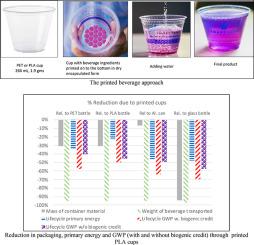Resources, Conservation and Recycling ( IF 13.2 ) Pub Date : 2023-05-28 , DOI: 10.1016/j.resconrec.2023.107050 Deepak Rajagopal

|
Packaging is either the largest or second-largest source of energy as well as multiple different environmental burdens across the lifecycle of many different beverages. Here we analyze the potential of a new approach to consuming beverages (and potentially other household liquids) with less energy and environmental burden. This involves printing the active ingredients on to a cup to which water is added just before consumption. When consumed with tap-water, beverages printed on PLA cups require 20%, 40% and 90% less packaging materials relative to Aluminum, plastic and glass-based packaging respectively. This yields a 23% – 48% reduction in lifecycle primary energy and 40% – 57% reduction in global warming potential (50% – 70% with biogenic carbon credit for landfilled-PLA). Sensitivity analyses suggest that the single greatest source of uncertainty in benefits of printed beverages is of a behavioral nature -whether one uses tap- or commercially bottled- water, which eliminates the benefits of printed beverages.
中文翻译:

通过印刷减少液态消费品的生命周期材料、能源和排放
包装是最大或第二大能源,也是许多不同饮料生命周期中的多种不同环境负担。在这里,我们分析了一种以更少的能源和环境负担来消费饮料(以及可能的其他家用液体)的新方法的潜力。这涉及将活性成分打印到杯子上,然后在饮用前加水。使用自来水饮用时,与铝、塑料和玻璃包装相比,印在 PLA 杯子上的饮料分别减少 20%、40% 和 90% 的包装材料。这使生命周期一次能源减少 23% – 48%,全球变暖潜能减少 40% – 57%(对于填埋的 PLA,生物源碳信用减少 50% – 70%)。


























 京公网安备 11010802027423号
京公网安备 11010802027423号